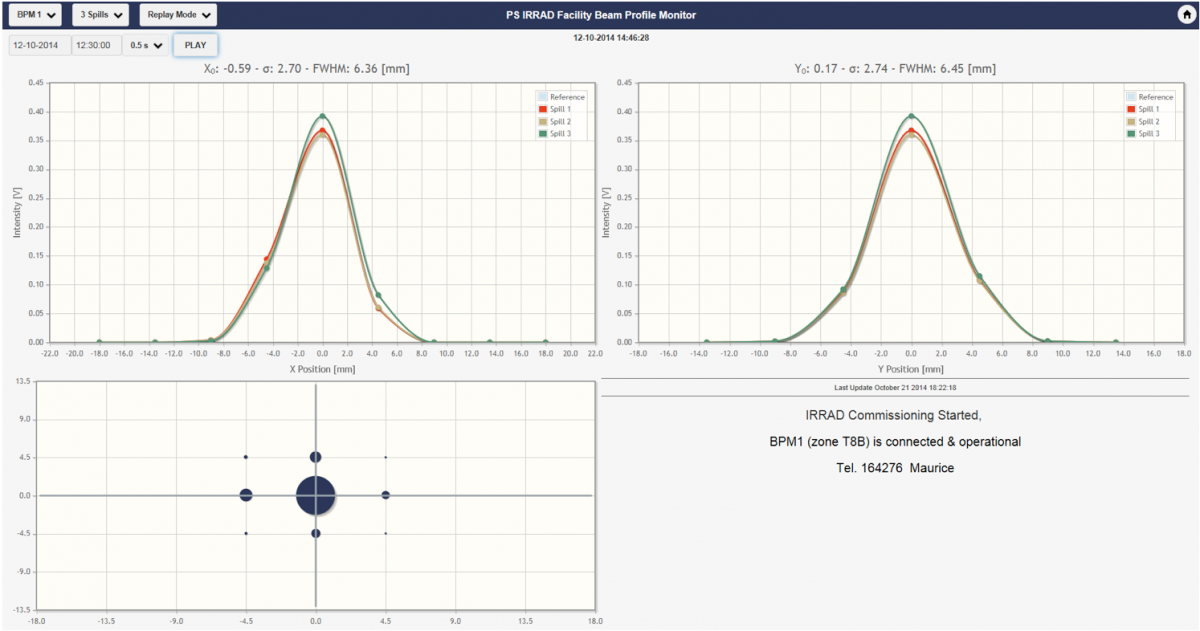First beams for the new East Area Irradiation Facility
On Friday October 10th 2014 at 21:13, for the first time, the primary 24 GeV/c proton beam slow-extracted from the PS went trough the new East Area Irradiation Facility (EA-IRRAD) reaching the beam dump located downstream the T8 beam line. This milestone signed the beginning of the exploitation of this new CERN infrastructure built as a joint effort between the PH and EN departments and within the framework of the AIDA project (www.cern.ch/aida). The EA-IRRAD facility is divided in two separated irradiation areas using the same T8 beam line: the proton IRRAD facility (www.cern.ch/irradiation) is located upstream of the mixed-field CHARM facility (www.cern.ch/charm). Both facilities can be operated in parallel using the same primary proton beam. In IRRAD, irradiation experiments are performed using the primary protons while, in CHARM, a mixed-particle radiation field is used after being generated by a 50cm thick copper or aluminium target. The new IRRAD is operated by the PH-DT group and it has been designed to cope with the increasing need for irradiation experiments of the PH experimental community working for the High-Luminosity upgrade of the LHC experiments. The new IRRAD is an upgraded version of the previous proton facility run by the PH department on the T7 beam line of the PS East Area since the early 90’s (see PH newsletter article). The CHARM facility, operated by the EN-STI group, is optimized to reproduce the radiation environment of the LHC tunnel and the typical shielded areas of the CERN accelerator complex.
The first weeks of operation, using a low intensity proton beam, are mainly devoted to the beam steering and commissioning in order to study several T8 optics configurations required for the parallel operation of IRRAD and CHARM. Moreover, this pilot beam is also used to test and calibrate the T8 beam instrumentation. This includes Secondary Emission and Ionization chambers, a MWPC device and the IRRAD Beam Profile Monitors (BPM) that are installed along the beam trajectory in the IRRAD area. The IRRAD BPMs are pixelated metal-foil detectors based on the secondary electrons emission effect. A typical profile of the irradiation beam, taken with a BPM during the first days of operation, is shown in the picture. Four BPMs are installed in the IRRAD area allowing a precise and real-time tagging of the proton beam shape/intensity in the irradiation positions acting as a key element for the tuning of the proton irradiation beam. The commissioning is performed together with the secondary beam-line physicist and the BE-OP operator crew which controls the irradiation beam from the CCC.

In parallel with the beam commissioning, the work on the EA-IRRAD infrastructure continues. This includes the assembly of the storage area, the completion of the ventilation system, which is now being tested, and the radiation shielding on the top of the facility (roof shielding). To allow a smooth continuation of the installation works, irradiations of materials and components inside IRRAD are not allowed for the time being, as well as the usage of the CHARM target. This aims to reduce to the absolute minimum the residual activation inside the irradiation areas before completion of the installation works.
According to the present schedule, the remnant construction works should be over within a couple of weeks allowing the first irradiation experiments to be performed during week 47 and for the following three weeks until the end of the beam to the PS East Area foreseen on Sunday December 14th.
The PH-DT Irradiation Team: B. Gkotse, M. Glaser, P. Lima, M. Moll and F. Ravotti
